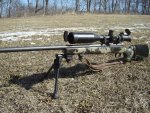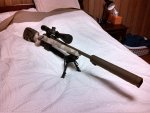Culpeper -
I’m aware that the original M40 was essentially a factory Remington varmint rifle. Modern references to the M40 profile barrel usually refer to the later specification, heavier, straight tapered barrels that were adopted as a result of the M40 product improvement program, which ultimately resulted in the fielding of the M40A1, M40A3, and so on. It is this barrel profile that I believe the OP was referring to, otherwise he wouldn’t have commented on the added weight of the replacement barrel being excessive, as it would be essentially the same as the barrel he already has. I don’t dispute that you saw no advantage between the barrels you described, as neither of them were the M40 profile I was talking about. They were both varmint weight, factory barrels. Even if your barrel had the heavier profile, the sample size of one each would limit the relevancy of your results to only those individual barrels, used under the specific conditions you encountered. The scientific method dictates that when gathering data from testing, the larger the sample size, the more accurate and relevant the data produced. A sample size of one is completely irrelevant and produces no data that can be applied globally.
Supercorndogs -
The heavier contour is not the only feature that would provide an advantage, but it does provide one nonetheless. The larger diameter, and increased mass provides increased stiffness in barrels of the same length. This increases accuracy through improved barrel harmonics. The heavier barrel also takes longer to heat up. These two qualities combined produce a barrel that is more thermally stable than a slimmer barrel with a similar level of internal stress. This is simple physics, and were it not the case, military sniper rifles would not have used these heavy profiles for over forty years. Similarly, bench rest rifles would have no reason to use even heavier profiles. Therefore, all other things being equal, the heavier barrel will be more consistently accurate than the lighter one. Match barrels, such as those you referenced, in spite of having a varmint contour, are manufactured to tighter tolerances, using more precise production methods, and better stress relief procedures than a factory mass produced barrel, thus we rightfully expect superior performance when compared to a factory barrel. This explains why your factory barrels’ groups opened up as they got hot, while your match barrels are more consistent.
Sandwarrior -
There may be a misunderstanding concerning the specific profile I was referring to. As I said above, I was referring to the later, heavier, straight tapered barrels, as, I believe, the OP was. The Remington tribute rifle was essentially model 700 varmint or police rifle with a wood stock. That is a slight oversimplification, but concerning barrel contour, accurate enough for the purpose of my example. This was also true of the original M40 from the sixties. Not only are standard grade barrels available with this contour, but this is the same contour that is on the OP’s rifle. That’s why I assumed he was talking about the later profile. If I was mistaken, the OP can correct me. No one said he should look for a barrel based on the profile alone. I didn’t initially address any of these other details, because the OP only asked about the advantage of the heavier contour. I never said there was any magic in it. In fact, if there is any magic, it’s in the shooter. The rifle is just a tool, but the better the tool, the better the magic.
I did not disagree with the validity of 308pirate’s point about other profiles being indistinguishable from the M40, as far as their effect on accuracy. I took exception to the attitude with which he expressed it. I’m not here to do myself favors. I’m here to learn and share when I can. I intend to do that civilly and with respect, as long as I’m afforded the same courtesy. The first part of his post was neither civil, or respectful. I took it to be sarcastic and rife with condescension. If i misinterpreted his intent, I will gladly apologize, but until he lets me know that, my comment stands. I bear no ill will towards him. I don’t even know him. I have read other posts he has made in other threads, and felt he made a valid contribution to the discussion, and I’m sure I will again. However, when someone throws the gauntlet at my feet, I tend to pick it up and knock their teeth out with it. It’s not personal, just handle business and move on.
Supersubes -
I don’t believe I am overstating the benefits of the heavy profile. I merely stated that they exist, not that they were the most important consideration. I’m not, nor have I been pushing the M40, or any other profile. I simply answered the OP’s question, in simple terms. I never said a barrel had to be heavy to be accurate. Hard use rifles, particularly military sniper rifles, have used heavy barrels, not only for the benefits stated above, but as a measure of protection from the external forces encountered in a rough environment. Benchrest rifle use very heavy barrels for extreme thermal stability. If you’re not looking to set the next BR world record, or beat your rifle against rocks and trees while playing on a two-way range, then you can probably get by with a lighter profile and get away with it. However, some people just like the look of a heavy profile, even if they don’t need it, and that’s okay too. I’ve got both, and I like both.
The rifles you mention have barrels that have probably benefited from manufacture using vastly improved stress relief methods than were available even a few years ago. Thus they may posses the thermal stability of a much heavier profile. The entire precision rifle industry has seen exponential improvement in recent years. The rifles you mention all have chassis, instead of traditional stocks. This includes a rigid forend tube that fully encloses the barrel, except for the last few inches of the muzzle end. This would afford enough protection from external forces to reduce the need for the heavier profile. They also all incorporate a user changeable barrel system. If one did manage to damage the barrel, it is easily replaced at the unit level. This also alleviates the need for the heavier profiles, as the rifle can be kept in service. Additionally, since the extra mass is no longer a necessity, using the trimmer profiles helps offset the weight increase of the heavier chassis, and all the stuff we hang on the rifle these days.
I apologize for this incredibly long post. I just wanted to clear up any misunderstandings, or misconceptions. I won’t be posting on this thread again unless there is a new development. If anyone doesn’t get the concept by now, they’re either not capable of understanding, or they have their own agenda to promote. Good talk, though.




